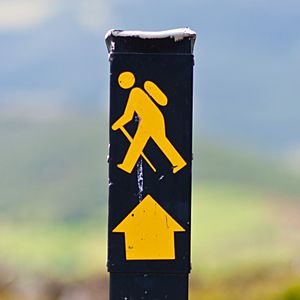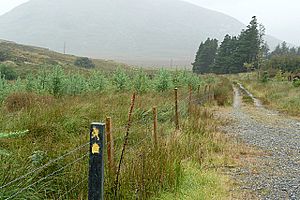Lists of long-distance trails in the Republic of Ireland facts for kids
Ireland has many long-distance trails for you to explore! These include walking paths, old pilgrim routes, cycling greenways, and special mountain paths with boardwalks. They are all looked after and kept in good condition.
There are 43 National Waymarked Trails, managed by the Irish Sports Council. Each trail has special yellow signs with a walking man symbol and an arrow. This symbol is only used for these national trails. The oldest trail in Ireland is the Wicklow Way, which opened in 1980. Now, there are over 4,000 kilometres (about 2,500 miles) of these marked trails across the country. Some of the most popular trails are the Wicklow, Sheep's Head, Kerry, Dingle, Beara, Burren, and Western Ways.
Since 1997, the Heritage Council has been creating walking routes based on old medieval pilgrimage paths. These are special routes people used to walk for religious reasons a long time ago. Now, there are 124 kilometres (about 77 miles) of these main pilgrim trails. These include Cnoc na dTobar, Cosán na Naomh, St. Finbarr's Pilgrim Path, Saint Kevin's Way, and Tochar Phádraig. These and seven other pilgrim trails are supported by the Pilgrim Paths of Ireland group.
In 2017, the 46-kilometre (29-mile) Waterford Greenway opened for cyclists. Many more greenways are being planned or built. Some of Ireland's National Waymarked Trails are also part of bigger trails that cross countries, like the European walking route E8, the Beara-Breifne Way, and the International Appalachian Trail.
Contents
National Waymarked Trails
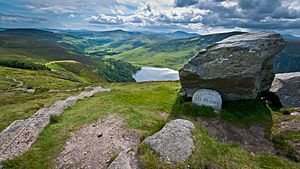
In the 1970s, a trail called the Ulster Way opened in Northern Ireland. This inspired Ireland to create its own network of long-distance trails. A special committee was set up, which included J. B. Malone. He helped make walking popular through his newspaper articles, TV shows, and books. The very first trail in Ireland, the Wicklow Way, was based on articles Malone wrote in 1966. It opened in 1980. After that, more trails followed, like the South Leinster and East Munster Ways in 1984, and the Kerry Way and Táin Way in 1985.
It was sometimes hard to get permission to build trails on private land. So, most trails use land owned by the state. Coillte, Ireland's state forestry company, manages the most trails. They look after over 30 National Waymarked Trails. Coillte provides and maintains a lot of the walking trails in Ireland. Because of these access issues, many trails have long parts that are on public roads.
In 2006, a plan for Irish trails said that they needed to improve to meet international standards. Getting access to land was the most important issue. A 2010 review suggested creating a new type of trail called a 'National Long Distance Trail' (NLDT). These would be top-quality trails. Five trails were suggested to be upgraded: the Beara, Dingle, Kerry, Sheep's Head, and Wicklow Ways.
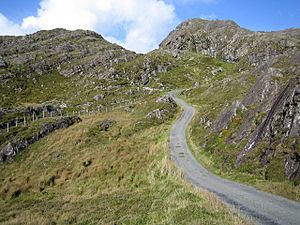

| Name | County | Format | Start | End | Length |
|---|---|---|---|---|---|
| Ballyhoura Way | Cork; Limerick; Tipperary | Linear | St John's Bridge | Limerick Junction | 89 km (55 mi) |
| Barrow Way | Carlow; Kildare; Laois | Linear | Robertstown | St Mullin's | 100 km (62 mi) |
| Bealach na Gaeltachta – Slí an Earagail | Donegal | Circular | Dunlewey | Dunlewey | 77 km (48 mi) |
| Bealach na Gaeltachta – Slí Cholmcille | Donegal | Circular | Ardara | Ardara | 65 km (40 mi) |
| Bealach na Gaeltachta – Slí Chonamara | Galway | Closed | |||
| Bealach na Gaeltachta – Slí na Finne | Donegal | Circular | Fintown | Fintown | 51 km (32 mi) |
| Bealach na Gaeltachta – Slí na Rosann | Donegal | Circular | Dungloe | Dungloe | 65 km (40 mi) |
| Beara Way | Cork; Kerry | Circular | Glengarriff | Glengarriff | 206 km (128 mi) |
| Blackwater Way (Avondhu) | Cork; Tipperary | Linear | Clogheen | Bweeng | 94 km (58 mi) |
| Blackwater Way (Duhallow) | Cork; Kerry | Linear | Bweeng | Shrone | 67 km (42 mi) |
| Bluestack Way | Donegal | Linear | Donegal | Ardara | 65 km (40 mi) |
| Burren Way | Clare | Linear | Lahinch | Corofin | 114 km (71 mi) |
| Cavan Way | Cavan | Linear | Dowra | Blacklion | 22 km (14 mi) |
| Croagh Patrick Heritage Trail | Mayo | Linear | Balla | Murrisk | 61 km (38 mi) |
| Dingle Way | Kerry | Circular | Tralee | Tralee | 162 km (101 mi) |
| Dublin Mountains Way | Dublin | Linear | Shankill | Tallaght | 55 km (34 mi) |
| East Clare Way | Clare | Circular | Killaloe | Killaloe | 180 km (110 mi) |
| East Munster Way | Waterford; Tipperary | Linear | Carrick-on-Suir | Clogheen | 75 km (47 mi) |
| Grand Canal Way | Dublin; Kildare; Offaly | Linear | Lucan Bridge | Shannon Harbour | 117 km (73 mi) |
| Hymany Way | Galway | Linear | Portumna | Aughrim | 55 km (34 mi) |
| Kerry Way | Kerry | Circular | Killarney | Killarney | 214 km (133 mi) |
| Leitrim Way | Leitrim, Cavan | Linear | Leitrim | Dowra | 27 km (17 mi) |
| Lough Derg Way | Limerick; Clare; Tipperary | Linear | Limerick | Dromineer | 65 km (40 mi) |
| Lung Lough Gara Way | Roscommon; Sligo | Linear | Castlerea | Corradoo | 58 km (36 mi) |
| Mid Clare Way | Clare | Circular | Newmarket-on-Fergus | Newmarket-on-Fergus | 148 km (92 mi) |
| Miners Way and Historical Trail | Sligo; Roscommon; Leitrim | Circular | Arigna | Arigna | 118 km (73 mi) |
| Monaghan Way | Monaghan | Linear | Monaghan | Inishkeen | 65 km (40 mi) |
| Multeen Way | Tipperary | Linear | Milestone | Tipperary Town | 23 km (14 mi) |
| Nore Valley Way | Kilkenny | Linear | Kilkenny | Inistioge | 34 km (21 mi) |
| North Kerry Way | Kerry | Linear | Tralee | Ballyheigue | 45 km (28 mi) |
| Offaly Way | Offaly | Linear | Cadamstown | Lemanaghan | 37 km (23 mi) |
| Royal Canal Way | Dublin; Kildare; Meath; Longford; Westmeath |
Linear | Ashtown | Abbeyshrule | 79 km (49 mi) |
| Sheep's Head Way | Cork | Circular | Bantry | Bantry | 90 km (56 mi) |
| Slieve Bloom Way | Laois; Offaly | Circular | Glenbarrow | Glenbarrow | 84 km (52 mi) |
| Slieve Felim Way | Limerick; Tipperary | Linear | Murroe | Silvermines | 43 km (27 mi) |
| Sligo Way | Sligo | Linear | Larrigan | Dromahair | 78 km (48 mi) |
| Slí Gaeltacht Mhuscraí | Cork | Linear | Kealkill | Millstreet | 70 km (43 mi) |
| South Leinster Way | Carlow; Kilkenny; Tipperary | Linear | Kildavin | Carrick-on-Suir | 104 km (65 mi) |
| Suck Valley Way | Roscommon; Galway | Circular | Castlerea | Castlerea | 105 km (65 mi) |
| Táin Way | Louth | Circular | Carlingford | Carlingford | 40 km (25 mi) |
| Tipperary Heritage Way | Tipperary | Linear | Vee Gap | Cashel | 56 km (35 mi) |
| Western Way (Galway) | Galway | Linear | Oughterard | Leenaun | 55 km (34 mi) |
| Western Way (Mayo) | Mayo | Linear | Leenaun | Ballycastle | 124 km (77 mi) |
| Westmeath Way | Westmeath | Linear | Kilbeggan | Mullingar | 33 km (21 mi) |
| Wicklow Way | Wicklow; Dublin; Carlow | Linear | Marlay Park | Clonegal | 129 km (80 mi) |
Pilgrim Paths
Inspired by the famous Camino de Santiago in Spain, the Heritage Council started the Pilgrim Paths Project in 1997. The goal was to create and support walking routes along Ireland's old medieval pilgrimage paths. This helps people learn about the history and nature along these routes, and also helps local tourism.
In 2013, a group called Pilgrim Paths of Ireland (PPI) was formed. This group represents 12 local communities that support specific pilgrim paths. PPI holds a National Pilgrimage Paths Week every year during Easter. They also give out a National Pilgrimage Passport to people who finish the 5 main trails: Cnoc na dTobar, Cosán na Naomh, St. Finbarr's Pilgrim Path, Saint Kevin's Way, and Tochar Phádraig.
| Name | County | Format | Start | End | Length | Time | Difficulty |
|---|---|---|---|---|---|---|---|
| Cnoc na dTobar | Kerry | Linear; Mountain | St. Fursey's Holy Well | Knocknadobar mountain | 9.5 km (5.9 mi) | 3.5 hours | Moderate |
| Cosán na Naomh | Kerry | Linear; Mountain | Ventry Strand | Brandon mountain | 18 km (11 mi) | 4–5 hours | Moderate |
| St. Finbarr's Pilgrim Path | Cork | Linear | Drimoleague | Gougane Barra | 37 km (23 mi) | 2 days | Strenuous |
| Saint Kevin's Way | Wicklow | Linear | Hollywood or Valleymount | Glendalough | 30 km (19 mi) | 7 hours | Moderate |
| Tochar Phádraig | Mayo | Linear; Mountain | Ballintubber Abbey | Croagh Patrick mountain | 30 km (19 mi) | 10 hours | Moderate |
These routes use the same signs as National Waymarked Trails. They have black posts with a yellow pilgrim symbol. This symbol comes from an old stone found in County Cork. It shows a pilgrim with a special haircut, wearing a tunic, and carrying a staff. Below the symbol is an arrow with a cross, which is a main symbol of pilgrimage in Ireland.
Cycle Greenways
As of March 2021, Ireland has four main greenways. These are paths, often built on old railway lines, that are great for cycling and walking.
| Name | County | Format | Start | End | Length |
|---|---|---|---|---|---|
| Great Southern Trail | Limerick; Kerry | Linear | Rathkeale | Abbeyfeale | 35 km (22 mi) |
| Great Western Greenway | Mayo | Linear | Westport | Achill | 42 km (26 mi) |
| Waterford Greenway | Waterford | Linear | Waterford City | Dungarvan | 46 km (29 mi) |
| Royal Canal Greenway | Kildare;Meath;Westmeath;Longford | Canal way | Maynooth harbour | Longford, and Cloondara | 130 km (81 mi) |
There are plans to create a 50-mile (80-kilometre) Connemara Greenway on an old railway line. The Dublin-Galway Greenway is also being developed. Parts of this 280 km (174 mile) route follow the Royal Canal and an old railway line. Funding has been given to build a greenway on the old Tralee to Fenit railway line in County Kerry. More greenways are being considered across the country. The Royal Canal Greenway is also planned to be extended to Dublin, making it 144 kilometres (89 miles) long.
Boarded Mountain Paths
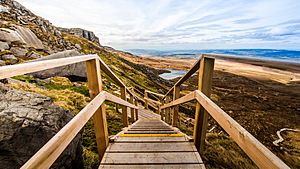
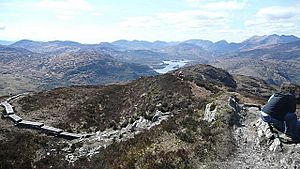
The Irish Office of Public Works (OPW) looks after several "boarded paths" on Irish mountains. These paths often use strong wooden planks, like old railway sleepers.
These paths were built to protect the soft ground, often bogland, from being worn away by walkers. But they also made the paths much more popular! For example, when the Stairway to Heaven opened in 2015, the number of visitors to Cuilcagh Mountain jumped from about 3,000 to over 60,000 each year.
As of June 2019, there are five main boarded mountain paths in Ireland:
- Cuilcagh "Stairway to Heaven" (Cavan/Fermanagh). This 7.5-kilometre (4.7-mile) path leads to the top of Cuilcagh mountain. It opened in 2015 to protect the bog, and it's now a big tourist spot.
- Diamond Hill. This 7-kilometre (4.3-mile) path of boards and stone starts and ends at the visitor centre in Letterfrack in Connemara. The mountain was closed in 2002 because of serious erosion. It reopened in 2005 after a 1.4 million Euro wooden boardwalk and stone path were built.
- Djouce (Wicklow). A 4-kilometre (2.5-mile) boarded path was built between 1997 and 1999. It protects the bog from erosion because many people enjoy walking on this mountain.
- Glendalough "Spinc/White Trail" (Wicklow). This 8-kilometre (5-mile) loop path goes around the mountains near the Upper Glendalough Lake. It offers amazing views of the valley below.
- Torc Mountain (Kerry). A boarded path to the summit allows walkers to complete the 8-kilometre (5-mile) route from Torc Waterfall to the top of Torc Mountain. You don't need special mountain shoes or navigation skills for this path.
Safety on Boarded Paths
In 2016, a walker named Teresa Wall sued the National Parks and Wildlife Service (NPWS) after she tripped on the Djouce boardwalk and cut her knee. She won money in a lower court. However, in 2017, the NPWS won an appeal in a higher court. The court decided that a "trip hazard" on a mountain path is different from one in a city. This means that people need to be careful when walking on these paths, as they are part of nature.
Interconnecting Trails
National Connections
The Beara-Breifne Way is a walking and cycling route being developed. It will run from the Beara Peninsula in County Cork to Breifne in County Leitrim. This route follows the path of an important historical march from 1602. It will use parts of existing trails like the Beara Way, Ballyhoura Way, Suck Valley Way, Miner's Way and Historical Trail, Leitrim Way, and Cavan Way.
International Connections
The European walking route E8 is a huge international walking trail. It stretches all the way from Dursey Island in County Cork, Ireland, to Istanbul in Turkey! In Ireland, the E8 follows parts of the Wicklow, South Leinster, East Munster, Blackwater, Kerry, and Beara Ways.
There's also a plan to extend the International Appalachian Trail (IAT) to Ireland. This trail is an extension of the famous Appalachian Trail in North America. The idea is to connect all the land that was once part of the ancient Appalachian Mountains when the continents were joined. The Irish part of the IAT would use the Slí Colmcille and the Bluestack Way in County Donegal before joining the Ulster Way in Northern Ireland.
See also


